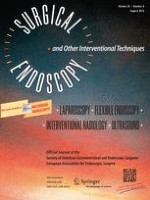01-08-2014
Gender influence on long-term weight loss after three bariatric procedures: gastric banding is less effective in males in a retrospective analysis
Published in: Surgical Endoscopy | Issue 8/2014
Login to get accessAbstract
Background
Identifying factors that influence weight loss after bariatric surgery is one way to predict a successful surgical outcome. Knowledge of the effect of gender on weight loss after bariatric surgery has not been well demonstrated in the literature despite being noted in every day practice. The aim of this study was to find the influence of gender on long-term weight loss after bariatric surgery.
Methods
A retrospective analysis of data retrieved from a prospectively maintained bariatric database was conducted.
Results
The study included 640 consecutive patients. Their mean age was 38 ± 10 years, mean preoperative body mass index was 44.9 ± 8.4 kg/m2, and mean preoperative excess weight (EW %) was 108.3 ± 38.4 %. The mean of the average excess weight loss (EWL %) was 43.3 ± 42.4 %. Three procedures were utilized: Roux-en-Y gastric bypass (RYGB), vertical banded gastroplasty (VBG), and gastric banding (GB). Both VBG and RYGB induced significantly more EWL % than GB (d = 22.1 %, p < 0.001 and d = 16, p = 0.02, respectively). In patients who underwent VBG and GB, males had significantly lower preoperative EW % (Student t = −4.86, p < 0.001, and Student t = 4.69, p < 0.001, respectively), and postoperative mean of the average EWL % (Student t = −2.43, p = 0.016, and Student t = −3.33, p = 0.002, respectively) than females. In patients who underwent RYGB, there were no differences in the preoperative EW % (t = −1.03, p = 0.309) or the mean of the average EWL % (t = 0.406, p = 0.688). The simple linear regression model used to explain the variability in EWL %, accounted for by the variability in the preoperative EW %, was significant (F = 180, p < 0.001). Analysis of the residual errors in predicting the EWL % revealed no significant difference between males and females after VBG and after RYGB (t = 0.117, p = 0.907 and t = 1.052, p = 0.3, respectively), while it was significant after GB (t = −2.999, p = 0.003).
Conclusion
From our experience, we suggest that GB not to be offered as a first choice for obese male patients.





